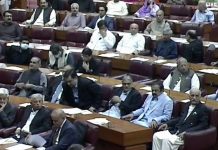Merely a fortnight after the Taliban took over Kabul and the western forces began their evacuation after almost 20-years of occupation, the Hamid Karzai International Airport was rocked by two suicide attacks that killed at least 175 Afghans and 13 US troops on Thursday. In retaliation, the US has conducted a drone airstrike in the Nangarhar province of Afghanistan that killed the ‘planner’ of the Islamic State-Khorasan Province on Friday, a day after the attack. Days before the appalling attack, American officials including US President Joe Biden had repeatedly warned that ISIS-K could strike the vulnerable Kabul airport.
President Biden has come under huge scrutiny after the terrorist attack on top of the ‘botched’ US withdrawal. Biden administration is under siege after reports suggested that the Pentagon shared intelligence with the Taliban regarding the under-risk Afghan citizens to provide them safe passage to the airport. Meanwhile, the CIA and other US intelligence agencies have warned of further “specific, credible” threats against the airport and the US embassy in Kabul has advised the Americans to avoid travelling to the airport because of security threats. The Taliban condemned the deadly attack as a senior Taliban commander said that the Taliban are interrogating some ISKP members in connection with the airport attack.
Within days after the Taliban took over Kabul, its spokesman Suhail Shaheen vowed that Afghanistan will not be a terrorist sanctuary. In the light of Shaheeh’s claims, the airport blasts present the Taliban with a conundrum. The attack was a tactical move by the ISIS-K against both the Taliban and the US. Firstly, it discredits the Taliban’s authority and gives a signal that the Taliban will find it difficult to ensure the safety of the Afghan public, especially the women and the minorities. Secondly, as Biden noted that the ISIS-K was the ‘declared enemy’ of the Taliban and the terrorist group will attack the Taliban and the US citizens alike.
In 2014, defectors from Al-Qaeda founded the Islamic State of Iraq and the Levant in Syria. The ISIL then took on their Jahbat al-Nusra, their Syrian affiliate. Similarly, disgruntled and more-hardline Taliban formed the ISKP or ISIS-K in 2015. The common denominator in both these scenarios is that the new faction deemed the original Taliban and the primary ISIS outfit to be not committed enough to the cause. The prospect of these renegades being even more radical than their parent organizations is frightening. The groups that make Taliban and the ISIS look better must be some monsters.
Instability fosters extremism and both Syria and Afghanistan have had the most optimal breeding ground for the birth of a plethora of extremist non-state actors, mostly with a skewed version of their religious ideology. Given the narrow variance in ideologies, the legitimacy of the Taliban in Afghanistan is predicated upon defeating their rivals who profess a relatively extremist version of their ideology, just like it was imperative for Daesh in Syria and Iraq to defeat the splinter groups to control the ideological narrative.
This is the primary threat that ISKP poses to the Taliban. The ISKP only has about 2,000 recruits according to several intelligence estimates. Despite its miniature strength, the group can take on the Taliban, especially with the Taliban numbers stretched across the country and the pressure on the Taliban to deliver on their promises on the global stage to earn international legitimacy and recognition.
The challenge ahead will not be a walk in the park for the Taliban.









